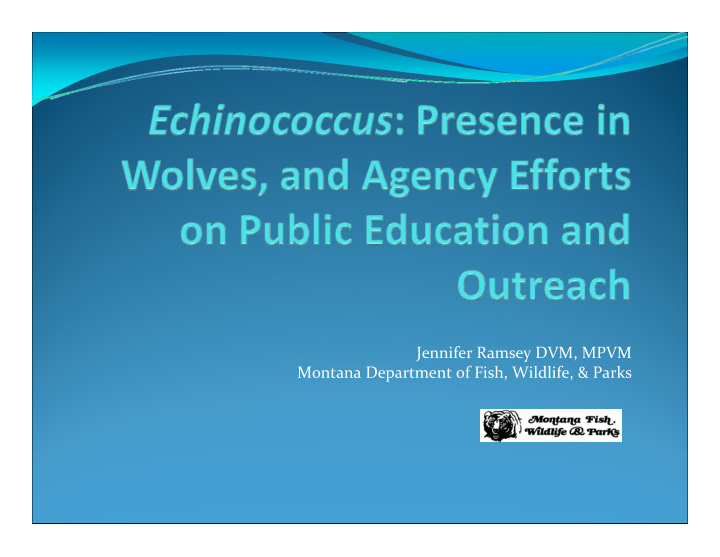



Jennifer Ramsey DVM, MPVM Montana Department of Fish, Wildlife, & Parks
What is Echinococcus? A genus of tapeworm Require two hosts to complete their life cycle Two species known to exist in Montana. E. multilocularis E. granulosus
Life Cycle of Echinococcus Source: CDC <http://www.dpd.cdc.gov/dpdx/html/Echinococcosis.htm>
Echinococcus multilocularis Typical definitive hosts include foxes, coyotes, wolves Typical intermediate hosts are rodents Known to exist in Montana for several years in coyotes and foxes (since at least 1976) Disease in humans is called Alveolar Echinococcus
1976 ‐ 1983
Echinococcus granulosus Montana Gray Wolf Status Report. Twenty Year Review of Health and Related Data: 1987 ‐ 2007. Montana Department of Fish, Wildlife and Parks. A. R. Gandolf et al., 2007 Echinococcus granulosus in Gray Wolves and Ungulates in Idaho and Montana, USA Foreyt et al., Journal of Wildlife Diseases, 2009
Potential Sources of E. granulosus in Montana Introduced with natural migration of wolves into Montana from Canada Maintained at low level in other canids prior to wolf reintroductions to YNP, and presence of the parasite on the landscape has been amplified by wolf presence. Introduced with wolves despite anthelmintic (dewormer) treatment prior to release
Echinococcus granulosus Domestic biotype Sylvatic biotype http://fieldguide.mt.gov “Molly” http://fieldguide.mt.gov “Rambo”
Echinococcus granulosus in the Wildlife Intermediate Host Infections in the intermediate host generally occur without evidence of significant impact on lung capacity. Hydatid cysts infecting moose or caribou lungs. Photo courtesy of NW Territories Department of Environment and Natural Resources .
Echinococcus granulosus: Human Infection Domestic biotype Human infection with the domestic biotype of E. granulosus is considered to be more severe than the northern biotype (McManus et al. 2002) Sylvatic biotype Human infection with this biotype of E. granulosus is considered by experts to be relatively benign (Rausch, 2003). “ A population of E. granulosus occurs in northern North America perpetuated in a sylvatic cycle between wolves, moose, and reindeer. This parasite does not readily infect domestic ungulates and in contrast with domestic strains of E. granulosus , is virtually asymptomatic in man” (from The Biology of Echinococcus and Hydatid Disease, ed. R.C.A. Thompson, 1986)
Echinococcus granulosus: Human Exposure Humans are exposed by ingesting eggs passed in feces of an infected canine. Infected domestic dogs pose highest risk of human infection Handling feces, fur, entrails of infected canine Consumption of contaminated vegetation Drinking contaminated water Eggs are very sensitive to desiccation and high temperatures
Precautions to Minimize Risk Do not allow dogs to consume carcasses Regular deworming of dogs who have potential to consume carcasses Wash hands after handling a dog that has access to carcasses. Do not touch or disturb wolf, coyote, or fox scat Wear latex or rubber gloves when handling or field dressing/skinning wildlife Wash/cook potentially contaminated vegetation; boil water.
Efforts on Public Education and Outreach Animal cleaning/gutting language included in deer and elk regulations Comparable language included in wolf hunting information distributed to public leading up to last year’s wolf hunt Additional information will be provided prior to initiation of a fall hunting season Staff availability for individual public questions, meetings, news releases Echinococcus fact sheet placed on website and distributed to staff and the public/media via The Wolf Weekly Led to several reporter calls and at least on news story in a major Montana daily newspaper To be developed: broader disease/animal health section on FWP b i
Recommend
More recommend